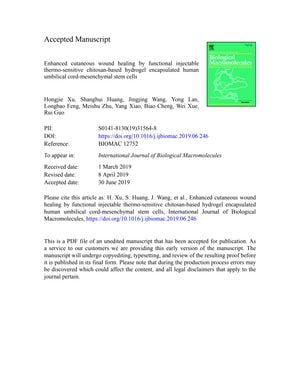Enhanced Cutaneous Wound Healing by Functional Injectable Thermo-Sensitive Chitosan-Based Hydrogel Encapsulated Human Umbilical Cord-Mesenchymal Stem Cells
July 2019
in “
International Journal of Biological Macromolecules
”
chitosan glycerol phosphate sodium cellulose nanocrystals human umbilical cord-mesenchymal stem cells hUCMSCs cutaneous wound healing hair follicle regeneration collagen deposition keratinocyte K1 TNF-α IL-1ß angiogenesis re-epithelialization glycerol phosphate stem cells wound healing hair regeneration collagen keratin tumor necrosis factor alpha interleukin-1 beta blood vessel formation skin regeneration

TLDR A new hydrogel with stem cells from human umbilical cords improves skin wound healing and reduces inflammation.
The study explored a new injectable thermo-sensitive hydrogel made of chitosan, glycerol phosphate sodium, and cellulose nanocrystals (CS/GP/CNC) that encapsulated human umbilical cord-mesenchymal stem cells (hUCMSCs) to improve cutaneous wound healing. The hydrogel's addition of cellulose nanocrystals enhanced its gelation speed, mechanical strength, and reduced its degradation rate. It was found to be injectable, minimally toxic, and significantly promoted wound closure, microcirculation, tissue remodeling, re-epithelialization, and hair follicle regeneration, while reducing inflammation. The hydrogel also increased collagen deposition and expression of the keratinocyte mature marker K1, and decreased inflammatory factors TNF-α and IL-1ß. Using a wound model in twenty rats, the hydrogel-hUCMSCs combination notably improved wound healing, especially in the early stages, by inhibiting inflammation, encouraging angiogenesis and re-epithelialization, and inducing hair follicle regeneration. The study suggests that this hydrogel-hUCMSCs combination could be a promising treatment for chronic cutaneous wounds.


